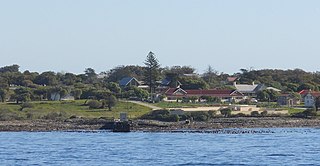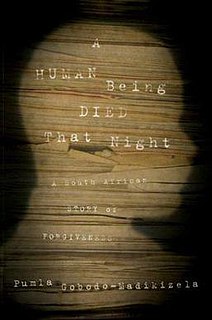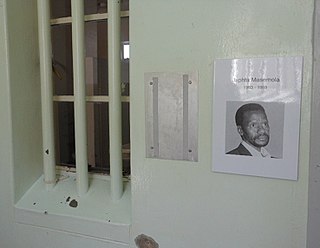
Robben Island is an island in Table Bay, 6.9 kilometres (4.3 mi) west of the coast of Bloubergstrand, north of Cape Town, South Africa. It takes its name from the Dutch word for seals (robben), hence the Dutch/Afrikaans name Robbeneiland, which translates to Seal(s) Island.
Raymond Mphakamisi Mhlaba was an anti-apartheid activist, Communist and leader of the African National Congress (ANC) also as well the first premier of the Eastern Cape. Mhlaba spent 25 years of his life in prison. Well known for being sentenced, along with Nelson Mandela, Govan Mbeki, Walter Sisulu and others in the Rivonia Trial, he was an active member of the ANC and the South African Communist Party (SACP) all his adult life. His kindly manner brought him the nickname "Oom Ray".

The Sharpeville massacre occurred on 21 March 1960 at the police station in the township of Sharpeville in the then Transvaal Province of the then Union of South Africa. After demonstrating against pass laws, a crowd of about 7,000 protesters went to the police station. Sources disagree as to the behaviour of the crowd; some state that the crowd was peaceful, while others state that the crowd had been hurling stones at the police, and that the mood had turned "ugly". The South African Police (SAP) opened fire on the crowd when the crowd started advancing toward the fence around the police station, and tear-gas had proved ineffectual. There were 249 victims in total, including 29 children, with 69 people killed and 180 injured. Some were shot in the back as they fled.

Robert Mangaliso Sobukwe was a prominent South African anti-apartheid revolutionary and founding member of the Pan Africanist Congress (PAC), serving as the first president of the organization.
The Azanian People's Liberation Army (APLA), formerly known as Poqo, was the military wing of the Pan Africanist Congress, an African nationalist movement in South Africa. In the Xhosa language, the word 'Poqo' means 'pure'.
Atteridgeville is a township located to the west of Pretoria, South Africa. It is located to the east of Saulsville, to the west of West Park; to the north of Laudium and to the south of Lotus Gardens. The settlement was established in 1939, and is named after Mrs MP Atteridge, chairwoman of the Committee for Non-European Affairs on the Pretoria City Council at the time. The Lucas Masterpieces Moripe Stadium is located in Atteridgeville.
Themba Harry Gwala was a revolutionary leader in the African National Congress (ANC) and South African Communist Party (SACP) in South Africa.
The Church Street bombing was a car bomb attack on 20 May 1983 in the South African capital Pretoria by uMkhonto we Sizwe (MK), the paramilitary wing of the African National Congress. The bombing killed 19 people, including the two perpetrators, and wounded 217. The Church Street Bombing was the most deadly attack by the ANC against South Africa's ruling National Party.

Eugene Alexander de Kock is a former South African Police colonel, torturer, and assassin, active under the apartheid government. Nicknamed "Prime Evil" by the press, De Kock was the commanding officer of C10, a counterinsurgency unit of the SAP that kidnapped, tortured, and murdered numerous anti-apartheid activists from the 1980s to the early 1990s. C10's victims included members of the African National Congress.
John Nyathi "Poks" Pokela was a South African political activist and Chairman of the Pan Africanist Congress (PAC).
Johnson Phillip Mlambo was a South African politician from Johannesburg.
Zephania Lekoame Mothopeng was a South African political activist and member of the Pan-Africanist Congress (PAC).
The Little Rivonia Trial was a South African apartheid-era court case in which several members of the armed resistance organization Umkhonto we Sizwe faced charges of sabotage. The accused were: Laloo Chiba, Dave Kitson, Mac Maharaj, John Matthews and Wilton Mkwayi. A confederate of theirs, Lionel Gay turned state witness, and in return, the prosecution dropped the charges against him.

A Human Being Died That Night is a 2003 book by Pumla Gobodo-Madikizela.

The White Liberation Movement was a small but notorious South African neo-Nazi organisation which became infamous after being banned under the Apartheid regime, the first right-wing organisation to be so banned. It regarded itself as the most far-right organisation in South Africa.
Pretoria Central Prison, renamed Kgosi Mampuru II Management Area by former President Jacob Zuma on 13 April 2013 and sometimes referred to as Kgosi Mampuru II Correctional Services is a large prison in central Pretoria, within the City of Tshwane in South Africa. It is operated by the South African Department of Correctional Services.

Jafta Kgalabi Masemola, also known as The Tiger of Azania and Bra Jeff, was a South African anti-apartheid activist, teacher, and founder of the armed wing of the Pan Africanist Congress (PAC). He spent 27 years in South African prison during the apartheid era in South Africa, and was released in October 1989, shortly before the legalization of the PAC and the African National Congress by F. W. de Klerk. He served the longest sentence of any political prisoner in Robben Island prison in South Africa.

Maximum Security Prison is an inactive prison at Robben Island in Table Bay, 6.9 kilometers (4.3 mi) west of the coast of Bloubergstrand, Cape Town, South Africa. It is prominent because Nobel Laureate and former President of South Africa Nelson Mandela was imprisoned there for 18 of the 27 years he served behind bars before the fall of apartheid. After that, three former inmates of this prison Nelson Mandela, Kgalema Motlanthe, and Jacob Zuma have gone on to become President of South Africa.

Devikarani Priscilla Sewpal Jana was a South African human rights lawyer, politician and diplomat of Indian descent. As a member of the African National Congress (ANC) during the anti-apartheid movement, she participated in both legal activism as well as in the underground movement to end apartheid. She represented many significant figures in the movement, including South African president Nelson Mandela, Winnie Madikizela-Mandela, Steve Biko, Govan Mbeki, Walter Sisulu, and Archbishop Desmond Tutu. Jana was one of the very few South Africans who had access to political prisoners, including Mandela, in the maximum security Robben Island prison, and served as an emissary for coded messages between the political prisoners and the ANC leadership.








